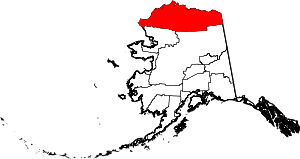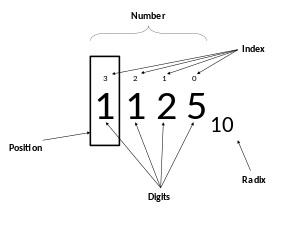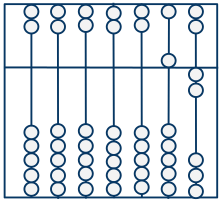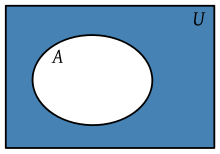Kaktovik Inupiaq numerals
Kaktovik Inupiaq numerals are a featural positional numeral system used by the Alaskan Iñupiat.
As the Inuit languages use a base-20 counting system, Arabic numeral notation (which is best used for a base-10 counting system) is rendered as inefficient. Students from Kaktovik, Alaska invented a new numbering notation in 1994[1] to rectify this issue, which has gained wide use among Alaskan Iñupiat, and has been considered in other countries where dialects of the Inuit language are spoken.[2]
The image below shows the numerals 1–19 and then 0. Twenty is written with a one and a zero, forty with a two and a zero, and four hundred with a one and two zeros, etc.
![]()
Background and problem
Inuit languages—like some other language groups—use a vigesimal (base-20) counting system, in contrast to decimal numeral system's base-10. Inuit counting has sub-bases at 5, 10, and 15. Arabic numerals, consisting of 10 distinct digits (0-9) are not adequate to represent a base-20 system.
Cultural changes required the Inuit to do long division math, which helped lead to the introduction of a written numerical system.[3]
The far north is a very unforgiving environment, so the numbers are very important to ensure that enough food was collected to survive the winter. Skins of large animals were grouped in bundles of five and smaller animals were bundled together in groups of 20, which was how the base-20 nature of the system developed.[3]
Sub-base 5
Inuit counting also has sub-bases at 5, 10, and 15. Also called quinary (base-5 or pental) this is a numeral system with five as the base.[4][5][6] The Kaktovik numerals take these sub-bases into account, as the base of the symbols change after 4, 9 and 14.
As five is a prime number, only the reciprocals of the powers of five terminate, although its location between two highly composite numbers (4 and 6) guarantees that many recurring fractions have relatively short periods.
Development
In 1998, during a math enrichment activity at Harold Kaveolook School in Kaktovik, Alaska,[1] some students mentioned that their own dialect was on a base 20 system, so that when they tried to write the numbers in Arabic they didn't have enough symbols to represent the Iñupiaq numbers.[7]

The students first addressed this by creating 10 extra symbols which made it difficult to remember and were so elaborate that it took a long time to write down the numbers. The entire middle school in the small town had nine students, so it was possible to involve them all in the discussion regarding the creation of the new system. Bartley, who had a more extensive background in linguistics than in mathematics, joined in.[7]
After brainstorming the students came up with a number of qualities that the system would have to have:
- The symbols should be easy to remember.
- There should be a clear relationship between the symbols and their meanings.
- It should be easy to write the symbols. For example, being able to be written without lifting the pencil, and should be able to be written quickly.
- They should look very different from Arabic numerals so there would not be any confusion between the two systems.
- They should be pleasing to look at.[7]
Notation
It is possible that the Iñupiaq have very high visual-perceptual skills, which might indicate a connection as to why the numeral system is very symbolic visually.[7]
A complication came with writing the number 20. Since it was a base for the system, the number needed to be written with a symbol for one and zero, but the Iñupiaq language does not have a word for zero. Again, going back to their language that the counting had been done on fingers or toes [20], the students decided that zero should look like crossed arms, meaning that nothing was being counted.[7]
When the middle school kids went to teach their new system to younger students in the school they noticed a tendency for the younger students to squeeze the numbers down to fit inside of the lines. In response, the middle students went back to create number frames to help formalize the system in how to write the numerals, setting a fixed maximum size. In this way, they accidentally invented a full positional numeral system with the bases forming in the top part of the frame.

This would also help in the visual aspects of doing long division.[7]
Spoken forms
The corresponding spoken forms are:
| 0 | 1 | 2 | 3 | 4 |
| atausiq | malġuk | piŋasut | sisamat | |
| 5 | 6 | 7 | 8 | 9 |
| tallimat | itchaksrat | tallimat malġuk | tallimat piŋasut | quliŋuġutaiḷaq |
| 10 | 11 | 12 | 13 | 14 |
| qulit | qulit atausiq | qulit malġuk | qulit piŋasut | akimiaġutaiḷaq |
| 15 | 16 | 17 | 18 | 19 |
| akimiaq | akimiaq atausiq | akimiaq malġuk | akimiaq piŋasut | iñuiññaŋŋutaiḷaq |
| 20 | ||||
| iñuiññaq |
The sub-base five shows in the grouping with the post-base of -gutailaq, which anticipates any number and groups the preceding set of five. This post base means that a number is less than the word stamped which is attached.[3] This can be troublesome at first for those unfamiliar with the system and language, but it does help as a linguistic aid to learn sub-base five mathematics[3] (for example, the number 19 is formed by subtraction from iñuiññaq 20, just as 9 is formed by subtraction from 10.)
Subtraction continues along the lines of French or Danish for the tens.
- qulit [10]
- iñuiññaq [20]
- iñuiññaq qulit [30] (20+10)
- malġukipiaq [40] (2*20)
- malġukipiaq qulit [50] (2*20+10)
- piŋasukipiaq [60] (3*20)
- piŋasukipiaq qulit [70] (3*20+10)
- sisamakipiaq [80] (4*20)
- quliŋuġutaiḷaq [90].
One hundred is tallimakipiaq (or qavluun) and 1000 is kavluutit.[8]
In the Greenlandic Inuit language:
| 1 | 2 | 3 | 4 | 5 | 6 | 7 | 8 |
| Ataaseq | Marluk | Pingasut | Sisamat | Tallimat | Arfinillit | Arfineq-marluk | Arfineq-pingasut |
| 9 | 10 | 11 | 12 | 13 | 14 | 15 | 16 |
| Qulaaluat, Qulingiluat, Arfineq-sisamat |
Qulit | Isikkanillit, Aqqanillit |
Isikkaneq-marluk, Aqqaneq-marluk |
In Greenland the numbers after 10 diverge. It is possible that the Inuit and Yupik dialects share the numbers from 1 to 10 and have evolved after they separated.[9]
Etymology
Iñupiat count on both their hands and feet. This was a way of keeping track of larger numbers, and using the whole body instead of just hands as in the decimal system. For example, the word for five (tallimat) is derived from the word for "arm" and the word for 10 (qulit) is derived from the word for "top", meaning both sets of fingers on the top part of the body. The word for 11 (qulit atausiq) in most Inuit dialects means something like “it goes down” as if it signified starting counting down on the toes. Going forward, the word for 15 (akimiaq) means something like “it goes across”. The number for 20 (iñuiññaq) in most dialects has something to do with the “entire person” or "one" or "complete person" or "all extremities."[3]
Doing computing with new symbols
Abacus


The students that invented the numerals also developed an Iñupiaq abacus in their shop.[1][10] The abacus helped to convert decimal numbers into the new base-20 numerals. The upper section of the Abacus with three beads representing the sub bases also showed the non-standard positional numeral systems in their upper sectors.[7]
Arithmetic
An unusual advantage of this new system was that arithmetic was actually easier than with the Arabic numerals.[7] Adding two symbols together would automatically look like their sum. For example,
It got even easier for subtraction. One could look at the symbol and remove the proper number of legs on the symbol to come to the answer.[7]
Another advantage came in doing long division. The visual aspects and its sub-base five made long division with very large dividends almost as easy as short division problems and didn't require multiplying or subtracting.[11] The students could keep track of the strokes on the paper with colored pencils.[7]
Cuisenaire rods such as those used in the Montessori method were developed to help and teach the system to the younger students. Popsicle sticks and rubber bands represented the sub bases.[7]
The students continued to make discoveries on their own. For example, one discovered complements of sets by seeing what was missing visually in the image of the numbers.[7]

Legacy
The numeral system has helped to revive counting in Inuit languages, which had been falling into disuse among Inuit speakers due to the prevalence of the base-10 system in schools.[1][10]
In 1996, the Commission on Inuit History Language and Culture adopted the numerals to represent the numbers in the Inuit language.[7]
In 1995, the middle school students moved over to the high school in Barrow (now renamed Utqiagvik), Alaska, and took their invention with them. The high school students were given permission to teach the middle school students this systems, the local community Iḷisaġvik College added an Inuit mathematics course to its catalog.[7]
As a result, in 1997, the student scores in the middle school on the California Achievement Test in mathematics, which was used to measure student success, increased dramatically. Previously, the average score was in the 20th percentile, and after the introduction of the new numerals, the scores rose to be above the national average.[7]
This dual thinking in base-10 and base-20 might be comparable to advantages that bilingual students have in forming two ways of thinking about the world.[7]
In 1998, 20 month calendars were available with the new numbering system.[12]
The system has since gained wide use among Alaskan Iñupiat, and has been considered in other countries where dialects of the Inuit language are spoken.[2]
Significance
The invention of the numeral system showed Alaskan-native students that math was embedded in their own culture and not simply imparted by a western culture. Those students going on to college saw studying mathematics as a necessity to get into college. Also, non-native students can see a practical example of a different world view which is a part of ethnomathematics.[13]
References
- Bartley, Wm. Clark (January–February 1997). "Making the Old Way Count" (PDF). Sharing Our Pathways. 2 (1): 12–13. Archived (PDF) from the original on June 25, 2013. Retrieved February 27, 2017.
- Regarding Kaktovik Numerals. Resolution 89-09. Inuit Circumpolar Council. 1998. http://www.inuitcircumpolar.com/resolutions7.html Archived 2017-02-02 at the Wayback Machine
- Clark, Bartley William (2014). Iñupiatun Uqaluit Taniktun Sivuninit/Iñupiaq to English Dictionary (11 ed.). Fairbanks: University of Alaska. pp. 831–841. ISBN 9781602232334.
- "Sharp_EL-W531 operating guide" (PDF). Archived (PDF) from the original on 2017-07-12. Retrieved 2017-06-05.
- "Sharp_EL-W506-W516-W546 operating guide" (PDF). Archived (PDF) from the original on 2016-02-22. Retrieved 2017-06-05.
- "Sharp_EL-W531X operating guide" (PDF). Archived (PDF) from the original on 2017-07-12. Retrieved 2017-06-05.
- Hankes, Judith Elaine; Fast, Gerald R. (2002). Changing the Faces of Mathematics. pp. 225–235. ISBN 978-0873535069.
- "Inupiaq numbers".
- Dorais, Louis-Jacques (2010). The Language of the Inuit: Syntax, semantics and society in the Arctic. ISBN 9780773536463.
- Hankes, Judith Elaine; Fast, Gerald R. (2002). Perspectives on Indigenous People of North America. p. 255. ISBN 978-0873535069.
- Grunewald, Edgar (December 30, 2019). "Why These Are The Best Numbers!". YouTube. Retrieved December 30, 2019.
- Noble, Abbey (February 28, 1998). "Native Numbers". New Moon. p. 36.
- Engblom-Bradley, Claudette (2009-01-01). The Alaska Native Reader. p. 244. ISBN 9780822390831.